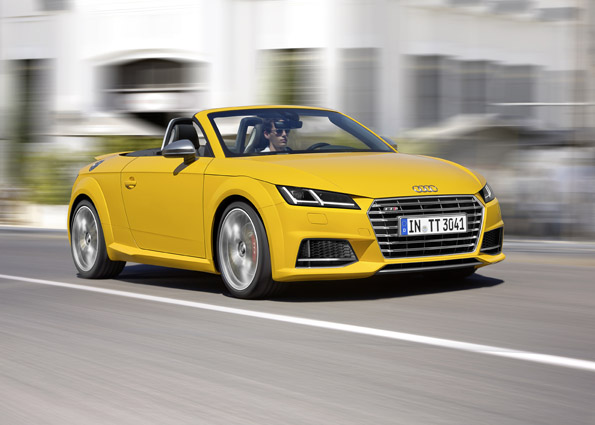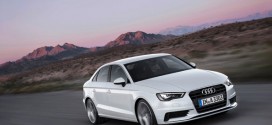After the best first quarter in the company’s history, Audi also sold more cars in April: around 152,850 deliveries exceeded prior-year sales in April by 2.5 percent. Demand again increased in all regions of the world compared with the same month of the preceding year. AUDI AG’s business developed positively especially on the American continent: deliveries to customers climbed by 12.7 percent. From January to April, global unit sales of the company thus grew by 5.2 percent to around 591,050 premium automobiles.

“Audi remains on course and posted a solid sales performance in April. Despite the upcoming generation changes in key model families and sales markets we have surpassed the record figures of the previous year,” says Luca de Meo, Board Member for Sales and Marketing at AUDI AG. “In the coming months we intend to continue growing worldwide.”
In the U.S., Audi sales in the past month grew by 7.5 percent to 16,827 units. In particular, the brand’s SUVs were in high demand among U.S. customers: altogether, sales of the Q models increased by 35.6 percent to 6,447 units. Across all models, deliveries by Audi of America have increased since the beginning of the year by 11.9 percent to 56,925 units, marking significantly faster growth than the U.S. market as a whole. Double‑digit growth for the month of April was reported in the region by Canada (up 36.6% to 3,219 cars) and Brazil (up 67.5% to 1,856 cars).
In Europe, Audi concluded the past month slightly above the figures for April 2014 and delivered around 71,750 cars to customers, 0.9 percent more than a year ago. Key Western European markets such as Italy (up 22.4% to 5,225 cars),Spain (up 15.8% to 4,100 cars) and Sweden (up 21.1% to 1,879 cars) led the monthly balance sheet as growth drivers. The Western European region reported a sales increase of 3.1 percent to around 67,300 cars for April. Cumulatively, Audi unit sales in this region amounted to around 262,550 cars, an increase of 4.6 percent. The brand’s full‑size category models in particular are experiencing significantly increasing demand in the Western European markets. Sales of the updated Audi A6* already available there have risen by 15.8 percent since January to around 32,250 cars delivered. Also the new Audi Q7* is drawing strong customer interest for the brand’s top segment: advanced orders for the full‑size SUV are already on a high level, ahead of its market introduction. The model will premiere at dealer showrooms in first markets from mid‑year on and will start to be handed over to customers at that time.
In Russia, the negative market trend continued also for Audi in April: since the beginning of 2015, local sales have declined by one‑third (down 31% to 8,248 cars). By contrast, the brand with the four rings has enjoyed strong momentum in Turkey; the A3 Sedan* in particular has attracted customers to the dealerships. 6,829 additional Turkish Audi drivers represent an increase of 47.7 percent during the first four months of the year; growth for April even amounted to 54.8 percent.
In the Chinese market, Audi sold 178,612 cars so far this year, 5.2 percent more than in the same period of 2014. In April, 45,296 sales were at the high level of the prior‑year month. In Spring 2014, Audi introduced the new A3 Sportback* and the A3 Sedan as an additional member of the model family to Chinese dealerships and thereby significantly strengthened its position in the strategically important segment of premium compact cars. With the A3* and the Q3*, Audi is also the leading premium manufacturer in the compact segment in China. Audi is already selling more premium compact cars in China than in any other market, even though the share of compact cars in the Chinese market as a whole is still low compared to the international level.
| Sales for AUDI AG | In April | Cumulative | ||||
| 2015 | 2014 | Change from 2014 | 2015 | 2014 | Change from 2014 | |
| World | 152,850 | 149,046 | +2.5% | 591,050 | 561,894 | +5.2% |
| Europe | 71,750 | 71,152 | +0.9% | 279,000 | 271,505 | +2.8% |
| – Germany | 25,663 | 25,503 | +0.6% | 98,871 | 91,961 | +7.5% |
| – UK | 13,126 | 12,630 | +3.9% | 58,907 | 56,301 | +4.6% |
| – France | 5,712 | 5,691 | +0.4% | 20,321 | 20,272 | +0.2% |
| – Italy | 5,225 | 4,270 | +22.4% | 17,821 | 16,807 | +6.0% |
| – Spain | 4,100 | 3,541 | +15.8% | 16,422 | 15,060 | +9.0% |
| – Russia | 2,116 | 3,660 | -42.2% | 8,248 | 11,946 | -31.0% |
| USA | 16,827 | 15,653 | +7.5% | 56,925 | 50,881 | +11.9% |
| Mexico | 957 | 951 | +0.6% | 4,152 | 4,026 | +3.1% |
| Brazil | 1,856 | 1,108 | +67.5% | 5,870 | 4,223 | +39.0% |
| China (incl. Hong Kong) |
45,296 | 45,216 | +0.2% | 178,612 | 169,736 | +5.2% |
Fuel consumption of the models named above:
Audi A3:
Combined fuel consumption in l/100 km: 8.3 – 1.5;
Combined CO2 emissions in g/km: 194 – 35
Audi A3 Sportback:
Combined fuel consumption in l/100 km: 8.3 – 3.4;
Combined CO2 emissions in g/km: 194 – 89
Audi A3 Sedan:
Combined fuel consumption in l/100 km: 7.1 – 3.5;
Combined CO2 emissions in g/km: 164 – 92
Audi Q3:
Combined fuel consumption in l/100 km: 8.4 – 4.4;
Combined CO2 emissions in g/km: 198 – 114
Audi A6:
Combined fuel consumption in l/100 km: 9.6 – 4.2;
Combined CO2 emissions in g/km: 223 – 109
Audi Q7:
Combined fuel consumption in l/100 km: 8.3 – 5.7;
Combined CO2 emissions in g/km: 193 – 149
 FastMotoring Motor News In Speed
FastMotoring Motor News In Speed


